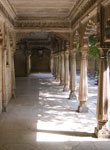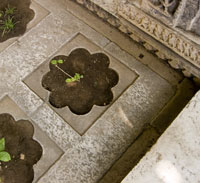The City Palace
I arrived in Udaipur in the early morning disembarking from the train bleary eyed and just awake enough to walk past the touts into the first hints of urban sprawl and find a rickshaw that I was pretty sure wasn’t looking for a kickback.
I told him to head to Lal Ghat which is the area I wanted to stay in rather than any specific hotel, lest I find it had suddenly burned down or gone out of business or was run by a very nasty man who breeds cockroaches or any of the other fantastical stories I have heard from touts. But this guy just shrugged and took me where I wanted to go. Once we got to Lal Ghat a man hopped in beside me and started in about his hotel. Luckily for him I was too exhausted to protest much and I agreed to at least look at it. It turned out to be a very nice family run guesthouse that was cheap, immaculately clean, had a lovely rooftop restaurant and, amazingly enough, hot water. All this for a mere Rs 150 a night.
I tried briefly to sleep but decided that was a waste and set out to explore. I didn’t feel up to much and was planning to just walk around for a while and maybe have a bite to eat, but I ended up walking right up to the City Palace Gate. I figured why not and bought a ticket for the museum. The City Palace is sort of a generic name for a whole bunch of palaces that were built over the years, each adding on to what existed before it. Legend has it that the founding Mewar ruler who started it was chasing a hare and when his dog cornered to hare the hare kicked the dog in the face so hard that the dog backed down. So rather than getting a new, tougher dog, the king took it as a sign and built a palace on the hill. Based on what I overheard guides telling other groups, nearly every successive ruler seemed to feel the need to expand and add his own touch to the legacy of what is now City Palace, kind of like the never ending construction projects you see around Boston. So the term City Palace refers to the whole collection and serves chiefly to distinguish it from the Lake Palace (now a hotel) and the Monsoon Palace high atop a nearby mountain.
After touring the museum section, seeing the various rooms and deciding that Mewar rulers had a serious glass and mirror fetish, I came to a sort of hanging garden courtyard that was just off what was once the King’s bathtub, though that term hardly does justice to the massive swimming pool sized bathing area. The garden was ringed on all sides by arched colonnades and then within those were trees and decorative planters intermixed with benches.
 The best comes from W.G. Sebald in his novel Austerlitz where a passenger pigeon was sent out somewhere and on its journey home it broke its wing and so, with an obsession that borders on human, it walked home over god knows how many miles. And yes it is a novel so it’s ostensibly fiction, but I find that well written fiction is often much closer to the truth than things that confine themselves to facts.
The best comes from W.G. Sebald in his novel Austerlitz where a passenger pigeon was sent out somewhere and on its journey home it broke its wing and so, with an obsession that borders on human, it walked home over god knows how many miles. And yes it is a novel so it’s ostensibly fiction, but I find that well written fiction is often much closer to the truth than things that confine themselves to facts.
I continued to sit there for quite some time listening to rustling trees and the various guides bringing small groups of western and Indian tourists through the garden. Each and everyone of the guides made a point to say that the King’s bath, which was just behind my seat on the bench and sunken slightly into the middle of the garden, to say that this bath was in fact the absolute center and highest point of the mountain over which the palace was built, as if this detail would somehow shed some light on why in fact the bath of all things occupied this particular area when in fact, to me at least, it simply made it all the more curious. It reminded me of children’s book that Laura and I once gave to a friend’s daughter; it was a massively oversized and lavishly illustrated book that told the story of a king who refused to get out of the bath and instead made his ministers, advisors, cooks and even his wife conduct business by getting in the bath with him.
About two weeks ago while I was in Fort Cochin I was overwhelmed by the assault on the senses that India presents in both positive and negative aspects and to cope with it I started trying to notice the small details of things that I or anyone else often overlooks when confronted with any sort of overwhelming, novel experience. But the City Palace was confounding in many ways and stubbornly resisted my attempts to find its details.
I began to realize that perhaps palaces are in effect an attempt to so overwhelm one with a vast and seemingly endless array of details that it becomes impossible to single them out and that a palace’s architectural goal is instead to overawe one into a generalized sensation of wonder or perhaps even confusion. I tried to picture the various kings lying in the bath behind me alone staring at the marble edges or perhaps the leaves in the trees above or even the tiny little plants in their relief cut stone planters along the sides, perhaps he would have noticed that the plants grow in the negative space,  where the stone is not, the space that actually forms the pattern that has been cut into the stone, or maybe notice that the pattern of the planter is the same as that of the inlays in the marble around the bath, a sort of blunt flower shape that exists as negative space, similar perhaps to the way a king must exist not a person but a negative space into which is poured all the concerns of his land, his people, his economy, and his foreign affairs.
where the stone is not, the space that actually forms the pattern that has been cut into the stone, or maybe notice that the pattern of the planter is the same as that of the inlays in the marble around the bath, a sort of blunt flower shape that exists as negative space, similar perhaps to the way a king must exist not a person but a negative space into which is poured all the concerns of his land, his people, his economy, and his foreign affairs.
After a while an older Indian gentleman who appeared tired of the large tour he was partaking in, broke away from the group and sat down on the bench beside me. After asking where I was from and how long I had been in India and other such questions that all the Indians I meet want to know, he started talking about the sheer size of the marble blocks that made up the room around us, not to mention the equally massive stone blocks that formed the walls, all of which had to be dug up, cut to size and hauled up this mountain. We spoke for a while about what the workers lives must have been like in that time and how whatever they did and however they lived is not recorded anywhere in the museum. Eventually the shade of trees above us gave way and bench where we were seated became warm and then hot in the direct sunlight. The man never said another word, simply stood and nodded to me before wandering off to rejoin his tour and I headed back down out of the palace toward the city proper.
Thoughts?
Please leave a reply:
All comments are moderated, so you won’t see it right away. And please remember Kurt Vonnegut's rule: “god damn it, you’ve got to be kind.” You can use Markdown or HTML to format your comments. The allowed tags are
<b>, <i>, <em>, <strong>, <a>. To create a new paragraph hit return twice.